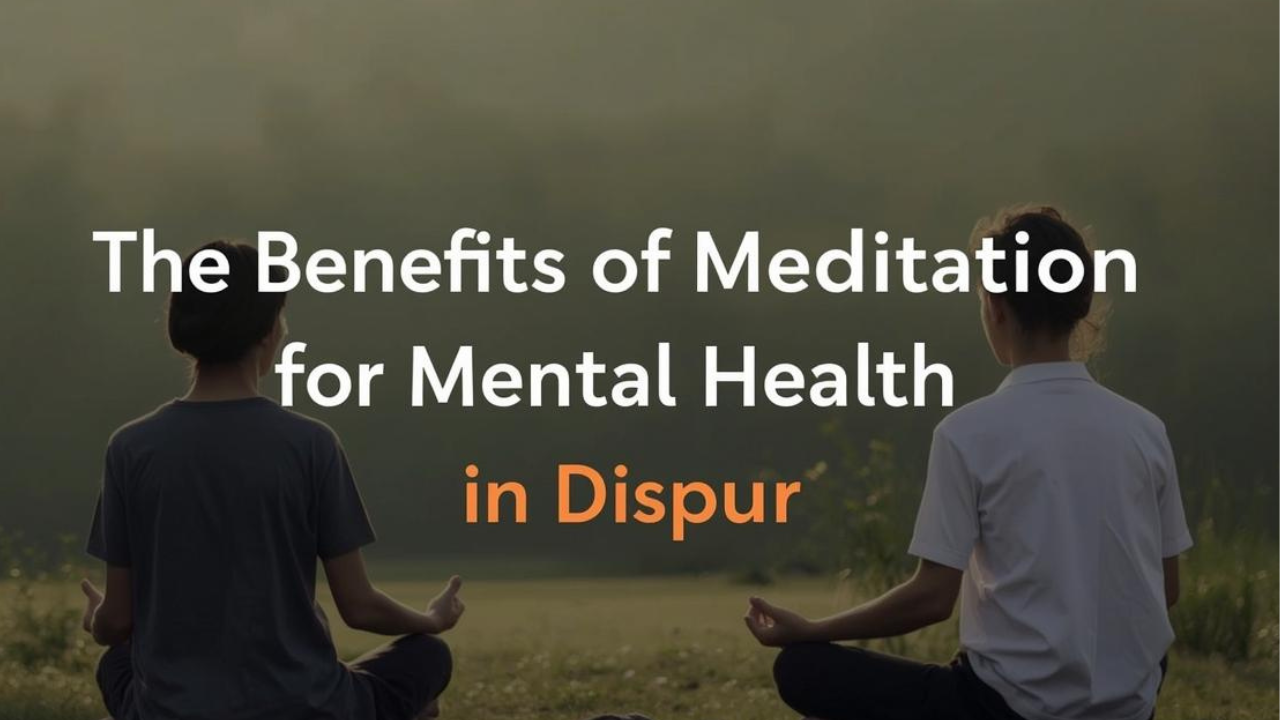
UK Chess Master Jailed 28 Months for Stalking Woma
Paul Keevil sentenced to 28 months for stalking, harassing, and blackmailing a woman in her 20s, hig

In Dispur, the capital region of Assam, a growing number of people are turning inward—toward meditation—as a tool for preserving mental health amid the pressures of modern life. As stress, anxiety, and burnout rise, meditation offers a centuries-old remedy with increasing modern relevance. This article examines the benefits of meditation for mental health, weaving in the local context of Dispur, global trends, scientific evidence, expert views, and practical guidance.
We begin by exploring the historical roots and evolution of meditation, especially in India, before moving to the the latest research, testimonials, public response, challenges, and pathways forward. We address who practices meditation in Dispur, what forms are common, when people engage in it, why it matters now more than ever, and how individuals and communities can harness its potential.
Meditation is an ancient practice, deeply rooted in India’s spiritual and philosophical traditions—particularly in Buddhist, Hindu, Jain, and yogic lineages. Techniques like dhyāna, metta (loving-kindness), vipassanā, mantra meditation, and mindfulness have been taught across monasteries, ashrams, and lineages for millennia. Over time, western psychology and neuroscience have adopted and adapted these practices into secular interventions: mindfulness-based stress reduction (MBSR), mindfulness-based cognitive therapy (MBCT), transcendental meditation, etc.
As globalization and wellness culture spread, meditation transcended religious identity and became a tool for mental health, stress management, and holistic well-being.
Dispur, like many growing urban centers in India, faces rising pressures: urbanization, traffic congestion, pollution, work and lifestyle stressors, educational competition, and social transitions. Mental health challenges—stress, anxiety, depression—are increasingly common.
Local wellness centers, yoga studios, NGOs, and meditation groups have begun offering guided sessions, sometimes free or subsidized. Many residents in Dispur now refer to studies, apps, and online resources for daily mindfulness practices.
Thus, Dispur sits at a crossroads: steeped in Eastern spiritual tradition yet facing the mental health challenges of modern city life. Meditation may offer a bridge between past wisdom and present needs.
Brain structure and connectivity
A meta-analysis of 78 functional neuroimaging studies showed distinct activation patterns for different meditation styles (focused attention, open monitoring, loving-kindness, mantra) in regions such as insula, dorsal anterior cingulate cortex, and frontopolar cortex.
Regular meditators tend to have increased gray matter density in brain areas tied to learning, memory, emotional regulation, and attention.
Attention, cognitive control & neuroplasticity
A study of a brief 10-minute meditation intervention in novices showed improvements in attention task performance (Stroop test) and favorable ERP markers (P200, P300), suggesting even short sessions can enhance cognitive control.
Over time, meditation seems to promote neuroplasticity—rewiring brain circuits toward calmer, more resilient patterns.
Autonomic & physiological effects
Meditation influences heart rate variability (HRV)—a marker of autonomic nervous system balance. In RKM practitioners, HRV analyses showed increased “calmness” and more coherent patterns post-meditation.
Other studies of HRV and heart-rate dynamics during meditation have found altered complexity and scaling behavior, pointing to a physiological shift toward parasympathetic (rest) dominance.
Stress, cortisol, inflammation
In a 2017 review of 45 studies, various meditation styles were shown to reduce physiological stress markers (e.g. cortisol, blood pressure).
Meta-analyses and randomized trials have shown that mindfulness-based interventions can reduce symptoms of anxiety and depression.
Beyond mental symptoms, meditation can reduce inflammatory signals, supporting both mental and physical health.
Sleep & emotional regulation
Multiple studies find meditation improves sleep quality — lowering the time to fall asleep, increasing sleep duration, reducing awakenings.
Meditation fosters emotional resilience and regulation: by training non-reactive awareness, individuals learn to observe—and not be swept by—strong emotions.
Based on converging evidence, the benefits of meditation for mental health include:
Stress Reduction / Relaxation
Meditation helps lower cortisol, reduce psychological stress, and calm the nervous system.
Anxiety Relief & Depression Symptom Reduction
Mindfulness meditation helps reduce rumination, negative thought cycles, and anxiety symptoms.
Cognitive Enhancement & Focus
Improvements in attention, executive control, working memory, and reduced distractibility.
Emotional Regulation & Self-Awareness
Greater capacity to observe thoughts/emotions, lower emotional reactivity, deeper insight and self-awareness.
Better Sleep & Recovery
Enhanced sleep onset and continuity, less nighttime rumination.
Physical Health & Autonomic Balance
Improved heart rate variability, lower blood pressure, reduced inflammation.
Resilience & Mental Well‑Being
Over time, consistent practice builds psychological resilience, preserves mental health under stress, and may guard against relapse in mood disorders.
While high-quality empirical studies specifically in Dispur or Assam remain limited, anecdotal and program-based reports suggest:
Wellness centers and yoga studios in Guwahati and Dispur report increased attendance in guided meditation classes.
Schools and colleges are gradually incorporating mindfulness sessions as stress management tools, especially during exam periods.
Local mental health NGOs sometimes integrate meditation or mindful breathing into community mental health workshops.
These grassroots steps reflect a growing receptivity to meditation as a mental health strategy in Dispur’s context.
Dr. Anjali Bhuyan, psychiatrist in Guwahati:
“In my practice, I’ve seen patients with anxiety or mild depression gain significant benefit when they incorporate daily mindfulness meditation—even just 10–15 minutes. It’s not a substitute for therapy or medication in moderate cases, but it supports stability, emotional regulation, and relapse prevention.”
Neuroscientist Dr. Ramesh Das:
“Meditation, when practiced regularly, appears to modulate brain networks—reducing hyperconnectivity in default mode network and strengthening prefrontal–limbic control circuits. This underpins improvements in mind wandering, rumination, and emotional balance.”
Mindfulness program leader, Assam Wellness Collective:
“We often caution beginners: start small, be consistent, and don’t push for perfection. The goal is to train awareness, not force calm. Over months, participants report better clarity, reduced stress, and deeper self-understanding.”
The NCCIH (National Center for Complementary and Integrative Health) notes that meditation and mindfulness practices are generally safe, though about 8% of participants in one review reported negative effects (e.g., anxiety, depression). NCCIH
Critics warn that some individuals—especially those with certain trauma histories or psychiatric vulnerability—may experience adverse effects such as dissociation, increased anxiety, or emotional destabilization if meditation is poorly guided or practiced too intensely.
These caveats highlight the importance of safety, appropriate guidance, and personalization.
In the U.S., reports suggest that between 2002 and 2022, the percentage of adults practicing meditation more than doubled (7.5% → 17.3%). NCCIH
Meditation and mindfulness-based interventions are now common in workplaces, schools, and health-care settings globally.
Technology has amplified access: apps like Headspace, Calm, Insight Timer, and regional Indian apps provide guided sessions, courses, and tracking.
Social media has popularized short meditative and “mindful minute” content, often to millions of viewers daily.
Recent articles in Times of India highlight the scientific insights behind meditation’s impact on brain and immune systems. The Times of India
Health media outlets regularly run “benefits of meditation” stories, contributing to mainstream awareness. Health+1
Debates appear around meditation’s limits—some popular pieces scrutinize potential downsides or overselling of “mindfulness as cure-all.”
Community groups and wellness centers have begun hosting free morning or evening meditation meetups at parks, community halls, and schools.
Mental health awareness events sometimes cite meditation as a cost-effective, accessible tool for stress reduction in local media.
Some skepticism persists among older generations or those unfamiliar with secular meditation, especially around religious associations.
Overall, the public response is cautiously enthusiastic—with curiosity, experimentation, and gradual adoption.
Meditation offers a relatively low-cost, accessible adjunct to mental health care:
Reduces stress and anxiety
Enhances emotional resilience
Supports cognitive clarity and focus
Improves sleep and recovery
Bolsters self-insight and coping capacity
While not a replacement for formal psychiatric or psychological interventions where needed, it can augment therapy, medication, lifestyle change, and preventive mental health strategies.
If widely adopted, meditation could ease burden on mental health services by equipping communities with preventive tools. Policymakers might integrate mindfulness practices into public health campaigns, school curricula, and community wellness initiatives.
Incorporating meditation in schools and colleges can help students manage exam stress, improve focus, reduce burnout, and support emotional regulation—potentially improving academic outcomes and well-being.
Companies already adopting employee well-being initiatives often integrate meditation or mindfulness as part of stress-reduction programs. Employees who meditate may show improved focus, lower absenteeism, and reduced emotional exhaustion—benefits for both well-being and productivity.
Meditation may contribute to greater mental health literacy, normalization of self-care, and destigmatization of mindfulness practices. Over time, community-level shifts in emotional regulation, compassion, and mental resilience may emerge.
Not all practices suit everyone; poorly guided meditation may trigger distress in vulnerable individuals.
Commodification risk: the “wellness industry” sometimes oversells or trivializes meditation, ignoring depth, context, and safety.
Accessibility gaps: rural, economically marginalized, or digitally disconnected communities may have limited access to guidance and quality instruction.
Superficial adoption: token gestures (e.g., “five-minute meditation breaks”) without deeper integration may yield shallow effects.
Some accessible forms include:
Mindfulness of breath: focusing on inhalation and exhalation
Body-scan meditation: gradually shifting awareness through the body
Loving-kindness (metta) meditation: cultivating goodwill toward self and others
Guided imagery / visualization
Walking meditation: slow, mindful walking
Mantra meditation: using a repeated phrase or sound
Begin with short sessions (5–10 minutes), gradually increasing duration as comfort grows.
Choose a quiet, comfortable place (corner, room, garden)
Sit with comfortable posture—cross-legged, on a chair, or cushion
Use cushions or props if needed
Aim for a consistent daily time (morning, after work, before bed)
Use apps, recorded guided meditations, or local teachers to assist
Seek local meditation classes, yoga centers, or community groups in Dispur
Online courses or apps can supplement live instruction
Guidance is valuable, especially early on
Mental health professionals should be consulted if you have existing psychological conditions
Meditation is a skill—it grows over time
Expect mind wandering; gently return attention
Avoid judging “good” or “bad” sessions
Consistency (daily or near-daily practice) typically yields cumulative effects
Use brief “micro-meditations” during daily routines (waiting in line, transitions)
Pair with breathwork, yoga, walking, nature time
Reflect on emotional shifts, journal insights
Monitor for signs of benefit or distress
Begin with gentle practices; avoid overly long or intense retreats without guidance
If you have a history of trauma, psychosis, severe depression, or PTSD, consult a mental health professional
Discontinue or adjust if meditation exacerbates distress, anxiety, or dissociation
Use secular, trauma‑informed, or guided approaches if religious framing is uncomfortable
Lack of local instructors or access
Misconceptions or stigma (viewed only as religious or “spiritual fluff”)
Impatience or unrealistic expectations
Inconsistent practice and drop-off
Adverse reactions in vulnerable individuals
Commercialization and superficial wellness fads
Overcoming these requires education, supportive communities, gradual scaling, and safeguarding practices.
More local research in Assam / Northeast India on meditation’s mental health impact
Integration of mindfulness into public health initiatives, schools, and workplaces
Creation of community meditation networks in Dispur (parks, libraries, social clubs)
Hybrid models combining in-person and app-based instruction
Emphasis on trauma-sensitive and inclusive meditation programs
Monitoring and reporting of adverse effects to balance hype with safety
In Dispur’s evolving social and mental-health landscape, meditation offers more than a spiritual relic—it presents a scientifically grounded, accessible tool for mental well-being. From stress reduction and emotional regulation to cognitive clarity and resilience, the benefits of meditation are well-supported by research. Yet, its promise hinges on consistent practice, appropriate guidance, safety-sensitive design, and cultural adaptation.
As Dispur and Assam engage deeper with wellness movements, meditation may become a bridge—linking ancient wisdom with contemporary mental health needs. For individuals, starting modestly and persistently, with openness and patience, can yield profound transformation over time. For communities and institutions, investing in guided programs, research, and mental health literacy can strengthen societal resilience.